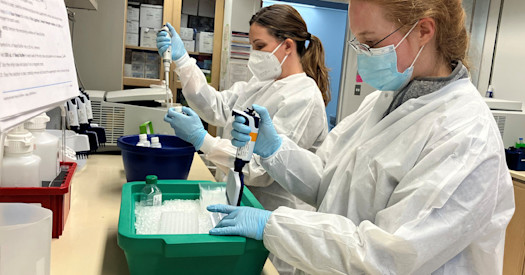 Nobuhiko Hamazaki (center) consults - and shares a laugh - with Post Doctoral Fellow Arata Wakimoto: 'People grow when they surround themselves with people who are motivated, creative, and engaging.'
Nobuhiko Hamazaki (center) consults - and shares a laugh - with Post Doctoral Fellow Arata Wakimoto: 'People grow when they surround themselves with people who are motivated, creative, and engaging.'
“By building something new, we can have a deeper understanding of how that new creation functions.” Nobuhiko Hamazaki
Nobuhiko Hamazaki and his lab are playing a significant role in building and understanding an extraordinary new creation. They are part of a biotechnology initiative often referred to as “science without limits:” The Seattle Hub for Synthetic Biology (Sea-Hub).
It is a five-year collaboration among the Allen Institute, the Chan Zuckerberg Initiative, the University of Washington, and the Brotman Baty Institute. Its mission is as complex as it is challenging – reengineer cells in humans to record their histories. Hamazaki, a UW Medicine Assistant Professor, joined Sea-Hub shortly after the project was launched last December.
“(Sea-Hub is) intended to help researchers crack the code to understand not just end-point measurements of cells and genes in health and disease, but also the dynamics of their trajectories over time,” according to the organizations’ joint press release. “(It) brings together the best of large-scale science and philanthropy with proven academic power to develop, refine, and share this single-cell technology.”
That “proven academic power” is being shepherded by Lead Scientific Director – BBI’s Jay Shendure. M.D., Ph.D. He has convened an outstanding team of four principal investigators:
- Jesse Gray, Ph.D., formerly with Ascidian Therapeutics and Harvard Medical School.
- Marion Pepper, Ph.D., Chair of the UW Medicine Department of Immunology.
- Robin Prentice, Ph.D., who joined BBI in 2019 and played a central role in helping establish at-home COVID testing for the greater Seattle area.
- Cole Trapnell, M.D., Ph.D., a Professor in the UW Department of Genome Sciences
Hamazaki’s contribution as a team lead is founded on his expertise in stem cell development, and in this case, focuses on human gastruloids – embryonic organoids composed of human stem cells. Over time, they form three-dimensional structures and mimic features of early mammalian development.
Hamazaki noted that human embryo development is “orchestrated by the interplay of external signals, such as morphogens and internal genetic networks” and that “recording these intra- and extracellular activities during human development lays the groundwork for advancing our understanding of human embryogenesis.”
Curiously, he compares the research he and his team conduct to playing with the popular children’s blocks Legos.
“We can learn a lot from assembling Lego blocks,” said Hamazaki, 37, who joined BBI and UW Medicine in 2023. “Imagine if our bodies were composed of Legos. You can take one Lego piece, break it down, and see how it functions in the body. Alternatively, you can try to assemble it with another Lego piece, and see how – or if – it fits into the larger Lego structure. This process of trial and error gives us many insights into how our bodies are made and what diseases can occur when any piece is missing.”
Legos, however, were not on Hamazaki’s mind when he enrolled in a high school biology course. He was 17-years-old and, while peering into a microscope, witnessed the conception of a sea urchin.
“I saw a sea urchin egg being fertilized,” he said. “It was the beginning of a new life. I was fascinated.”
That fascination led to Hamazaki enrolling in Hokkaido University in his native Japan. He completed a Bachelor’s Degree in Molecular Biology in 2010, then in 2012, he entered Kyoto University, a leading national research institution, pursuing Master’s and Ph.D. degrees in Developmental Biology and Bioinformatics.
Two essential questions: “How does life begin from a single oocyte?” and “How could an oocyte possess such amazing functions?”
Between 2015 and 2020, he served as a Postdoctoral fellow and later an Assistant Professor in Kyushu University, as well as a Special Research Fellow at the Japan Society for the Promotion of Science. During these five years Hamazaki decided to return to his fundamental motivation to be a scientist by answering two essential questions: “How does life begin from a single oocyte?” and “How could an oocyte possess such amazing functions?”
To understand this, Hamazaki decided to reconstruct the oocyte, a task he also compares to assembling Lego pieces. He succeeded in reconstituting the process of the oocyte development entirely in a dish and gained important insights into how oocytes are made.
By this time, Hamazaki was ready for new academic and professional challenges and to uncover answers on how life develops after an egg is fertilized. His arrival in Seattle in 2020 was followed by an interview with Shendure, who, Hamazaki said, was impressed with his views on synthetic biology.
“He asked me if we can reproduce an entire life cycle of mice in a dish by making oocyte and sperm from stem cells,” Hamazaki said.
Today, Hamazaki and the six members of his lab are ensconced in the UW Medicine complex in Seattle’s South Lake Union. In his office, among the many mementoes representing his career, is a Lego shopping bag.
So, is it likely that the challenges and opportunities of Sea-Hub will keep Hamazaki in the Puget Sound area? He does not hesitate in responding.
“The scientists I work with are truly inspiring,” he said. “I believe that people grow when they surround themselves with people who are motivated, creative, and engaging. These scientists are pulling me to an entirely new level of scientific study. I aspire to be that kind of person as well.”


